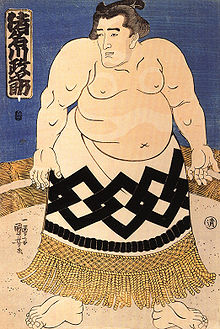Mawashi
A mawashi ( Japanese 廻 し or 回 し ) is the belt in sumo wrestling that fighters (rikishi) wear in competition and training. During the ceremony when entering the ring at the beginning of a tournament day (dohyō-iri) as well as during the " bow dance " (Yumitori-shiki) at the end of a day of fighting, wrestlers of the upper ranks wear a ceremonial keshō-mawashi (see below).
Battle Mawashi
The top tier rikishi mawashi is made from silk and comes in a wide variety of colors. Untied it has a length of about nine meters and a width of about 60 cm. He has a weight of four to five kilograms. These dimensions are the same for all mawashi, regardless of the wrestler's body size. Because of this, fighters with a relatively "narrow" build often seem to wear thicker mawashi than their larger counterparts. A mawashi is carried by folding it, wrapping it around the fighter's waist several times, passing it between his legs and finally tying it with a large knot at the back.
A series of starched silk strips , the so-called sagari ( 下 が り ) , are tucked into the front . The number of stripes is between 13 and 25 and is always odd. If they fall out during a fight, the Gyōji (referee) immediately throws them out of the ring if possible to prevent the rikishi from slipping. The Sagari are a reminiscence of the Keshō-mawashi (see below), which used to be worn during fights, although the apron-like part was finally dispensed with for practical reasons. They have no specific purpose other than decoration.
Should a mawashi become detached during a fight, the fight can be stopped to allow that fighter to re-tie their belt. If a wrestler loses his mawashi completely during a fight, he will be disqualified and his opponent declared the winner ( 不 浄 負 け , Fujō-make ). But this has not happened for many decades, at least in Japanese professional sumo.
The mawashi is more than a piece of clothing, it is an important part of the sumo sport, as many of the 82 victory techniques ( kimarite ) are based on grips on the opponent's mawashi, as this offers the best point of attack. However, handles on the vertical part of the mawashi, which passes between the legs, are strictly forbidden. Occasionally fighters try to get an advantage with little tricks: For example, if the mawashi is only tied very loosely, throws are more difficult. Others wrap the belt very tightly and sprinkle it with water to prevent the opponent from getting hold of it.
Although only the colors black, purple and dark blue are officially allowed by the Japanese Sumo Association , the latter tacitly looks over violations as long as the colors are not too light. The belt color of a wrestler often remains relatively constant: Musashimaru almost always wore a silvery gray, Asashoryu mostly fought in black. However, many sumo wrestlers are superstitious about the color of their mawashi. Often attempts are made to break a "streak of bad luck" by changing the belt color.
Silk mawashi are only worn in public fights. Heavy, cotton models are used during training . The members of the top two divisions, the so-called sekitori ( 関 取 ), wear white belts with a characteristic curved end. Sagari are not worn to it.
Lower division rikishi are required to wear black cotton belts both in competition and training. In competition, they supplement them with unstarched cotton sagari.
Finally, amateur fighters are limited in their selection to white cotton. However, the shape is different from that of the professional training mawashi.
Ceremonial Mawashi
Ceremonial Mawashi or Keshō-mawashi ( 化粧 回 し ) are those worn by the higher ranks in the solemn ceremonies in the ring. The silk "belt" has a kind of apron on the front, which is lavishly decorated and trimmed with golden fringes. Such mawashi easily cost a few thousand euros. Occasionally the Keshō-mawashi carries a reference to the sponsor of a fighter: The Bulgarian-born sumō wrestler Kotoōshū initially advertised a yoghurt brand on his ceremonial mawashi, for example , while the Ōzeki Chiyotaikai is adorned with the Bayer AG logo . Keshō-mawashi can also be gifts from fan clubs . Particularly popular wrestlers have a large number of such fan gifts.
Yokozuna , who perform in their own ceremony, have sets of three identical Keshō-mawashi, two of which are worn by their assistants.
